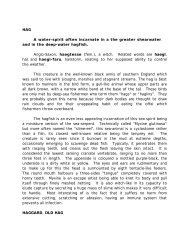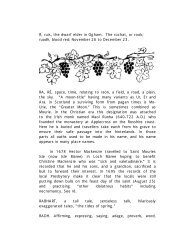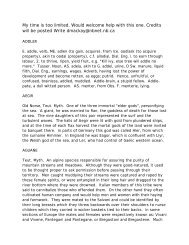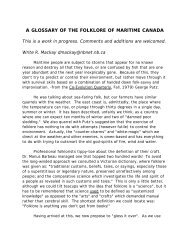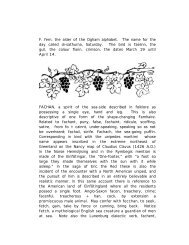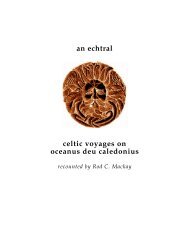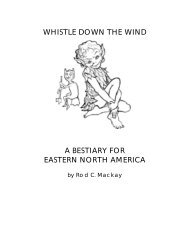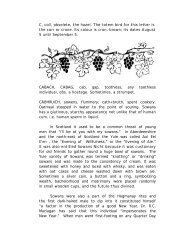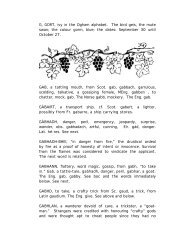L, luis, the mountain ash in the Ogham. Confers ... - Rodney Mackay
L, luis, the mountain ash in the Ogham. Confers ... - Rodney Mackay
L, luis, the mountain ash in the Ogham. Confers ... - Rodney Mackay
You also want an ePaper? Increase the reach of your titles
YUMPU automatically turns print PDFs into web optimized ePapers that Google loves.
usual sort. The person unfortunate enough to cut a Cailleach<br />
was sometimes called by this name and treated very roughly<br />
by his or her fellow reapers. Some were actually bound<br />
with<strong>in</strong> <strong>the</strong> last sheaf and dragged about, beaten, drenched<br />
with water, thrown upon <strong>the</strong> dung heap (hence <strong>the</strong><br />
expression: horse play) or thrown <strong>in</strong>to a brook. In less<br />
humane times he was burned, and <strong>in</strong> a better season he was<br />
merely <strong>the</strong> subject of ridicule, a person thought dest<strong>in</strong>ed<br />
for misfortune.<br />
The corn-spirit was, of course, considered to have<br />
been cut down with <strong>the</strong> reap<strong>in</strong>g so that he might be re<strong>in</strong>carnated,<br />
and <strong>in</strong> <strong>the</strong> past <strong>the</strong> reapers literally cut down<br />
his representative. In a p<strong>in</strong>ch <strong>the</strong> victim might be an actual<br />
member of <strong>the</strong> community but it was considered bettermannered<br />
to embody <strong>the</strong> corn-spirit <strong>in</strong> some pass<strong>in</strong>g<br />
stranger who was not familiar with <strong>the</strong> custom. Where<br />
human victims were scarce, a substitute might be found <strong>in</strong> a<br />
fox, dog, wolf, cock, hare, or some farm animal. This<br />
expla<strong>in</strong>s such expressions as "cutt<strong>in</strong>g <strong>the</strong> gander's neck" or<br />
"cutt<strong>in</strong>g <strong>the</strong> tail of <strong>the</strong> fox" as <strong>the</strong>y once applied to Harvest<br />
Home.<br />
LATHA CHOINNLE, The Day of Candles, Candlemas Day<br />
(February 2), mark<strong>in</strong>g <strong>the</strong> end of <strong>the</strong> Old Norse month of<br />
Yule, and <strong>the</strong> rule of <strong>the</strong> Cailleach Bheurr or W<strong>in</strong>ter Hag.<br />
This day was often referred to as Latha Mairi to dist<strong>in</strong>guish<br />
it from <strong>the</strong> pagan Latha Bridd or Bride’s Day (February 1).<br />
Never<strong>the</strong>less, <strong>the</strong> rites are disconcert<strong>in</strong>gly similar. On <strong>the</strong><br />
eve, candles were lighted <strong>in</strong> parish churches, and <strong>the</strong>se<br />
tapers were blessed and taken home as relics to be<br />
relighted aga<strong>in</strong>st <strong>the</strong> dangers of lightn<strong>in</strong>g and witchcraft.<br />
They clearly symbolize Lugh, <strong>the</strong> reborn sun, who was seen<br />
as ascendant at this time.<br />
On Candlemas Day <strong>the</strong> selection of a k<strong>in</strong>g and queen<br />
and <strong>the</strong> presentation of gifts to <strong>the</strong> druids fell <strong>in</strong>to <strong>the</strong><br />
hands of children and <strong>the</strong> local school-masters. In <strong>the</strong><br />
oldest form of <strong>the</strong> rites male children brought <strong>the</strong>ir gamecocks<br />
to school and <strong>the</strong> animals were pitted aga<strong>in</strong>st one



